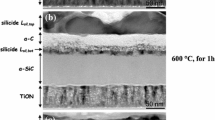Abstract
The problem of the manifestation of nanostructures properties that are not typical for similar macrosystems is still relevant. First of all, this concerns the stability of the thermodynamic properties of nanomaterials, which determines the operational reliability of devices based on them. In this paper, the influence of the nanostructured Si/Ni interface on the mechanism of silicide formation is studied. For this purpose, nickel/porous silicon nanocomposites have been electrochemically synthesized and analyzed using the scanning electron microscopy and the phase X-ray diffraction analysis. The solid-state interaction during heating the nanocomposites has been investigated using differential scanning calorimetry. The evolution of phase composition in the temperature range 25–500 °C has been studied. The temperature characteristics of silicide formation processes have been estimated. Kinetic analysis of the solid-state interaction has been performed using the isoconversional Ozawa–Flynn–Wall method. The dependence of effective activation energy on conversion has been calculated from the calorimetric data. The mechanism of silicide formation in the nickel/porous silicon nanocomposite is shown to be significantly different from the bulk Ni–Si diffusion couple. At the same time, it has similarities with, but also some differences from, the silicide formation in thin-film Ni–Si systems and individual Si nanowires. Methodical aspects of the characterization of the thermal behavior of nanocomposites taking into account the nanorelief of the Si–Ni interphase boundary are discussed.









Similar content being viewed by others
References
Murarka SP. Silicides for VLSI applications. New York: Academic Press; 1983.
Lavoie C, d’Heurle FM, Detavernier C, Cabral C Jr. Towards implementation of a nickel silicide process for CMOS technologies. Microelectron Eng. 2003;70:144–57.
Yaish YE, Katsman A, Cohen GM, Beregovsky M. Kinetics of nickel silicide growth in silicon nanowires: from linear to square root growth. J Appl Phys. 2011;109:094303.
Lin YC, Chen Y, Xu D, Huang Y. Growth of nickel silicides in Si and Si/SiOx core/shell nanowires. Nano Lett. 2010;10:4721–6.
Katsman A, Beregovsky M, Yaish YE. Formation and evolution of nickel silicide in silicon nanowires. IEEE Trans Electron Devices. 2014;61:3363–71.
Tu KN, Ottaviani G, Gösele U, Föll H. Intermetallic compound formation in thin-film and in bulk samples of the Ni–Si binary system. J Appl Phys. 1983;54:758–63.
Gülpen JH, Kodentsov A, van Loo FJ. Growth of silicides in Ni–Si and Ni–SiC bulk diffusion couples. Z Metallkd. 1995;86:530–9.
Olowolafe JO, Nicolet MA, Mayer JW. Influence of the nature of the Si substrate on nickel silicide formed from thin Ni films. Thin Solid Films. 1976;38:143–50.
Clevenger LA, Thompson CV, Cammarata RC, Tu KN. Reaction kinetics of nickel/silicon multilayer films. Appl Phys Lett. 1988;52:795–7.
Mangelinck D, Hoummada K, Panciera F, El Kousseifi M, Blum I, Descoins M, Bertoglio M, Portavoce A, Perrin C, Putero M. Progress in the understanding of Ni silicide formation for advanced MOS structures. Phys Status Solidi A. 2014;211:152–65.
Kummamuru RK, De La Rama L, Hu L, Vaudin MD, Efremov MY, Green ML, LaVan DA, Allen LH. Measurement of heat capacity and enthalpy of formation of nickel silicide using nanocalorimetry. Appl Phys Lett. 2009;95:181911.
Knauth P, Charai A, Bergman C, Gas P. Calorimetric analysis of thin-film reactions: experiments and modeling in the nickel/silicon system. J Appl Phys. 1994;76:5195–201.
Solanki CS, Bilyalov RR, Poortmans J, Celis JP, Nijs J, Mertens R. Self-standing porous silicon films by one-step anodizing. J Electrochem Soc. 2004;151:C307–14.
Ogata YH, Fukami K. Porous silicon and electrochemical deposition. In: Canham L, editor. Handbook of porous silicon. Basel: Springer; 2014. p. 629–37.
Clevenger LA, Thompson CV, Tu KN. Explosive silicidation in nickel/amorphous silicon multilayer thin films. J Appl Phys. 1990;67:2894–8.
Shilyaeva Y, Gavrilov S, Matyna L. Melting of indium, tin, and zinc nanowires embedded in the pores of anodic aluminum oxide. J Therm Anal Calorim. 2014;118:937–42.
Sherchenkov A, Kozyukhin S, Babich A. Estimation of kinetic parameters for the phase change memory materials by DSC measurements. J Therm Anal Calorim. 2014;117:1509–16.
Badea M, Budrugeac P, Cucos A, Eugen S. Thermal decomposition kinetics of bis(pyridine)manganese(II) chloride. J Therm Anal Calorim. 2014;115:1999–2005.
Ozawa T. A new method of analyzing thermogravimetric data. Bull Chem Soc. 1965;38:1881–6.
Flynn JH, Wall LA. A quick, direct method for the determination of activation energy from thermogravimetric data. Polym Lett. 1966;4:323–8.
Ravi KV. Imperfections and impurities in semiconductor silicon. New York: Wiley; 1981. p. 379.
Lu KC, Wu WW, Wu HW, Tanner CM, Chang JP, Chen LJ, Tu KN. In situ control of atomic-scale Si layer with huge strain in the nanoheterostructure NiSi/Si/NiSi through point contact reaction. Nano Lett. 2007;7:2389–94.
Acknowledgements
This work was performed as part of the state assignment No. 16.2653.2017/4.6 of the Ministry of Science and Higher Education of the Russian Federation.
Author information
Authors and Affiliations
Corresponding author
Additional information
Publisher's Note
Springer Nature remains neutral with regard to jurisdictional claims in published maps and institutional affiliations.
Rights and permissions
About this article
Cite this article
Shilyaeva, Y., Volovlikova, O., Smirnov, D. et al. Thermal and kinetic analyses of silicide formation at nanostructured Si/Ni interface. J Therm Anal Calorim 138, 2339–2345 (2019). https://doi.org/10.1007/s10973-019-08460-w
Received:
Accepted:
Published:
Issue Date:
DOI: https://doi.org/10.1007/s10973-019-08460-w




